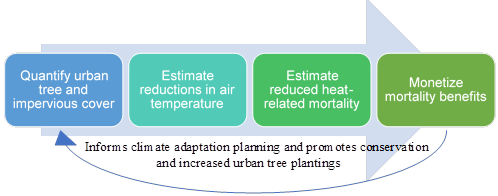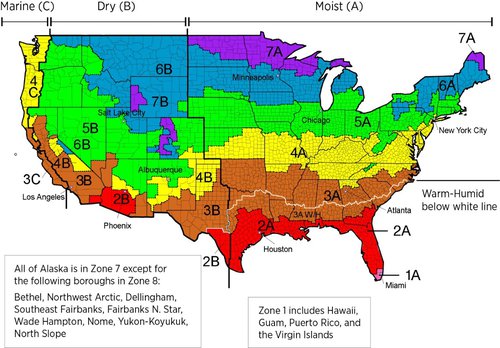National Assessment of Air Temperature Effects from Trees on Human Health
Trees have many benefits quantified by i-Tree Tools, and in this project, i-Tree has collaborated with Dr. Paramita Sinha of RTI International to expand the assessment of tree benefits to include an air temperature component. This project introduces a new process-based method for modeling the impacts of tree cover on air temperatures and heat-related mortality. We estimated changes in heat-related mortality for different tree cover change scenarios in selected cities across the United States. Method and results are intended to facilitate urban planning, scenario assessment and prioritization for urban forest management, and advocacy. Our project also builds on i-Tree capabilities to support climate adaptation strategies and address public health and environmental justice issues related to extreme heat.
Specific objectives for this project are to:
- Model the effect of urban trees on air temperatures across the United States using i-Tree Cool Air (Yang et al., 2013).
- Apply health impact functions from epidemiological literature to relate changes in air temperature to human health.
- Use benefits transfers to value changes in human health.
- Synthesize and disseminate results about tree effects on air temperature, health, and values.
This project is comprised of two related studies. The first study details the methodology and investigates the sensitivity of simulation year and health impact function used. The second study applies the methodology to ten cities across the United States, investigating variations in results for different climate, demographic, and land cover conditions.

Four-Step Approach to Quantify and Value Reduced Mortality Impacts Due to Temperature Reductions
Study 1: Modeling lives saved from extreme heat by urban tree cover
We introduced a method for quantifying and valuing changes in heat-related fatalities associated with changes in urban tree cover and we applied this method to Baltimore City, Maryland. This method is particularly relevant for adaptive strategies addressing climate change and vulnerabilities of aging populations. The full text for this study is available at Sinha et al. (2021).
Highlights
- Multidisciplinary method to quantify/value heat-related mortality impacts of trees
- Foundation for i-Tree heat component; decision-support for climate adaptation planning
- Increasing tree cover by 10% reduces heat-related deaths by 83 - 247 in Baltimore based on daily maximum temperatures
- Impacts for vulnerable populations; >50% of reduced mortality from people 65+ years
- Spatial distribution of impacts informs public health, equity, environmental justice issues
Citation: Sinha, Paramita; Coville, Robert C.; Hirabayashi, Satoshi; Lim, Brian; Endreny, Theodore A.; Nowak, David J. 2021. Modeling lives saved from extreme heat by urban tree cover. Ecological Modelling. 449(1): 109553. 19 p. https://doi.org/10.1016/j.ecolmodel.2021.109553.
Study 2: Variation in estimates of heat-related mortality reduction due to tree cover in U. S. cities
In a diverse set of cities across the United States, we assess heat-related fatalities avoided due to temperature reductions associated with increased tree cover. We estimate impacts throughout the season and on extremely hot days, and this has important policy implications for hot as well as cool cities. The full text for this study is available at Sinha et al. (2022).

- Phoenix, AZ
- Miami, FL
- Houston, TX
- Atlanta, GA
- New York, NY
- Albuquerque, NM
- Chicago, IL
- Los Angeles, CA
- Minneapolis, MN
- Salt Lake City, UT
Highlights
- More trees are an effective adaptive strategy for climate change in cool/hot cities
- Heat-related mortality reductions due to increase in tree cover vary across cities
- Demographics, land cover and local climatic conditions drive variations in impacts
- Hot/dry cities benefit more over summer; cool cities benefit on extremely hot days
- Spatial/temporal impacts; key for public health/environmental justice/land management
Citation: Sinha, Paramita; Coville, Robert C.; Hirabayashi, Satoshi; Lim, Brian; Endreny, Theodore A.; Nowak, David J. 2022. Variation in estimates of heat-related mortality reduction due to tree cover in U.S. cities. Journal of Environmental Management. 301 (113751) https://doi.org/10.1016/j.jenvman.2021.113751
Outreach
Major findings for this project were presented on September 8, 2021 by Dr. Paramita Sinha as part of the U.S. Forest Service webinar series Urban Forest Connections.
Acknowledgements
This project was made possible with funding from the 2018 U.S. Forest Service National Urban and Community Forestry Challenge Cost-Share Grant Program (Federal Award Identification Number 18DG-11132544-014) and an RTI internal grant.